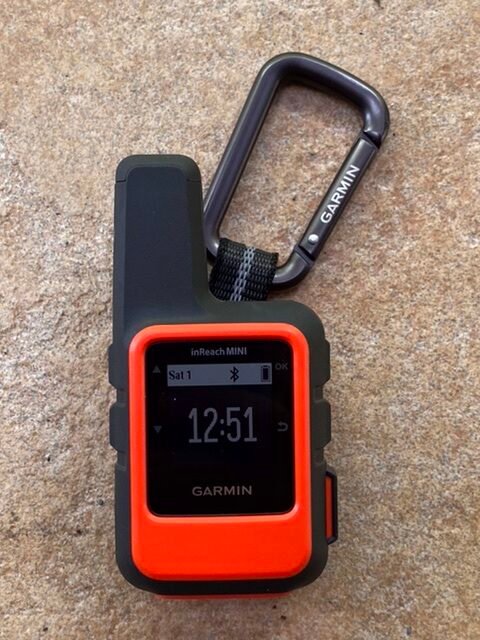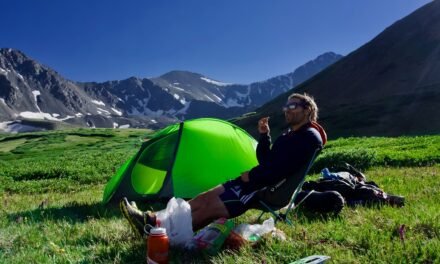You’ve probably heard of the 10 essentials – and if you haven’t now is an excellent time to read up on them! These are the basic items you should always have on any hike, whether a day hike or backpacking And are critical safety items. Actually, for backpacking, you already have some of these covered as you are expecting to be out overnight and you should have planned for that so, extra food, warm clothes, and shelter are already covered.
Let’s look at some of the other items.
Navigation

This is probably the most important item. I imagine the majority of problems in backpacking are related to getting lost and the majority of SAR (Search and Rescue) callouts are to find lost hikers. There are really quite a few options for navigation and digital technology plays an important role.
Maps & Compass

Always take a good topo map and compass of the region where you are going. This should always be in your kit and you need to know how to use it – that means being able to read a topo map, perform triangulation, locate yourself, account for declination, strike a bearing and follow it. If you are not confident in doing this then please take a course, research it online and then practice! REI again has good courses for learning map navigation.
My compass is a Suunto MC-2G. It’s perfect for the job!
Cell phone navigation
Digital technology plays a role too. This ranges from smartphones that have GPS with many supporting apps for navigation, such as ViewRanger, Alltrails, and Gaia to dedicated navigation devices from companies like Garmin. Again it’s really important you know how to use these devices before you head out. When you have no cell signal is not the time to find out you didn’t download the trail maps to use on your cell phone. This is how I use ViewRanger for navigation.
I now consider cell phones essential equipment. There are so many places you can get a cell phone signal. Especially when you are on a mountain. However, it‘s important if you are using it as a safety item to ensure you can charge it. See my section on electronics for more details.
PLBs and satellite messengers

Even though cell phones are great – there are plenty of areas where there are no signals. PLB (Personal locator beacons) and satellite messaging systems are lightweight solutions that will allow you to make an SOS call. Some of the systems will also allow you to text message with friends and family. These tend to be expensive ($200+) and I wouldn’t recommend needing these unless you are going to be on multi-day backpacking trips or you like to hike solo. I have a Garmin InReach Mini and you can see how I like it here.
Sun Protection
Protective clothing, sunglasses, and sunscreen. Getting sunburnt on the trail is pain – literally. And it’s very easy to do. At higher altitudes and with reflective snow it’s very easy to burn. My strategy here is very much focused on clothing. Although there are plenty of folks who can hike in shorts all day – I am not one of them and so I focus more on covering up, this also helps with bug protection. Good sunglasses are needed too – snow blindness is a real threat if you are hiking at higher elevations. There is definitely a trade-off on what type of sunglasses to get – they seem to be the most frequently lost item – so you should factor that in. I have some thoughts on sunglasses here.
Knife

If you are as old as I am – you might remember this Crocodile Dundee scene. Personally, I think big blades are very much overrated and I only hike with a small Leatherman CS. And to be honest I rarely have a need for this either. However, it‘s light (1.4oz) and has a blade, scissors, and file which is about enough for foot care and any other needs.
First Aid Kit
My first aid kit is described here.
Headlamp

Occasionally you might find yourself hiking at night, but more often you’ll need a headlamp because it‘s late when you get to camp and you need extra light for setting your camp and cooking. Or you need to take a pee break during the night. Make sure you have spare batteries and also make sure periodically to check your spare batteries and those in your headlamp and replace them as necessary. Outside of a headlamp, I don’t carry any other dedicated lights – both cellphones and power packs tend to have good lighting and so I don’t feel the need to being anything else. I use a Black Diamond – there are many varieties, with different powers, colors, and other features. Having red light is useful as it allows you to sit out at night without blinding each other.
Other Items
For firestarter, I carry two Bic lighters. One as part of my cook system and one as a backup. In the summer months, I rarely if ever light a campfire. The risks are too high on the west coast and in many areas, they are prohibited or prohibited above a certain height. So my lighters are for the stove and emergencies. In the shoulder seasons, Keenan & I have lit campfires. It’s well worth learning how to light a fire in damp and wet conditions – it can be a lot harder than it looks. Also only ever have a campfire in an existing fire ring and don’t cut or break any living trees.
If you are going into bear country you might need a bear vault. These are mandated in some areas to ensure proper food storage. Where bear canisters are not mandated you can hang your food – although a proper bear hang is much harder than it looks. There are also bear-resistant sacks, Ursack, that might be an option.
In Brown Bear areas you may want to consider bear spray, but again work out how to use and carry it before you need it. The NPS has good advice on what to do if you meet a bear.





